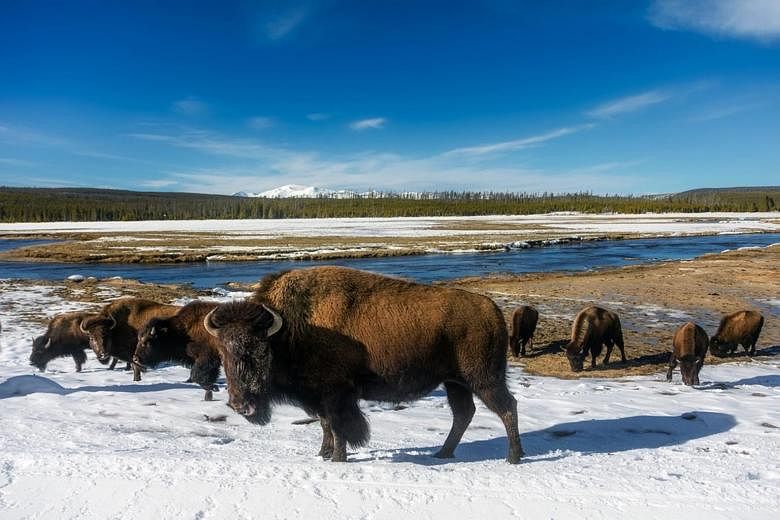WASHINGTON (NYTIMES) - It was a conservation success story: In 1902, fewer than 100 bison were scattered throughout the Great Plains, with poachers posing for photos beside thousands of skulls. More than a century later, 5,400 bison roam the fertile grounds of Yellowstone National Park.
But now, there are too many bison, according to the National Park Service.
Wildlife officials and tribal entities agreed last week that as many as 900 bison from Yellowstone National Park would be slaughtered, shot by hunters or placed in quarantine at the service's Stephens Creek Capture Facility, where the animals will be tested for brucellosis, a disease that causes abortions or stillbirths in cattle.
The horned, furry mammals have been overgrazing the land - causing possible mass starvation of other animals - and roaming into Montana, where farmers fear their cattle could become infected by brucellosis, the service said.
"Doing nothing is not a realistic option," the service said on its website, explaining why it was permitting the killing of an animal that was once at risk of extinction.
Most areas around Yellowstone continue to limit where bison are allowed, and human development on its habitat has hindered expansion of its range, the service said.
While wolves have recently made a healthy comeback in the park, they have had little effect in reducing the number of bison, which can stand 6 feet tall (183cm), weigh 2,000 pounds (907kg) and defend themselves easily as a group against predators.
Official said the bison would not be hunted inside Yellowstone, unlike in Grand Canyon National Park, where this year hunters were allowed for the first time to kill bison inside the park because they were causing havoc to the area's ecosystem.
The Yellowstone bison have been increasing by 10 per cent to 17 per cent every year. During the past two decades, wildlife officials have tried to curb some of that rapid growth, issuing yearly guidelines on how many bison should be killed.
Still, the park service said that the hunting had done little to solve the problem.
"Those bison are very wary," said Mr Chad Kremer, the owner of Kremer Buffalo, which raises and harvests bison in South Dakota. "They learn. They learn where those property boundaries are, where those limits are that they get pressure from the outside during the hunt."
Indeed, the service documented only two bison that were shot outside the park last year. Most of the 834 bison removed last year were herded into the Stephens Creek Capture Facility, tested for brucellosis and then transferred to tribes, which take the animals to slaughterhouses.
In 2019, the service introduced a programme in which bison that do not have brucellosis are transferred to new areas instead of slaughterhouses. That year, 55 bison were relocated to the Fort Peck Indian Reservation in north-eastern Montana.
Members of the tribes also have the option to hunt bison.
"Elders tell of a sincere and deep respect that when the wild roses bloomed in the late spring or early summer, they knew the bison calves were fattened up, and it was time to 'go to the bison'," the Confederated Salish and Kootenai Tribes said on a hunting orientation page.
When a bison is hunted, it is usually "a harvest", Mr Kremer said, because "they're so large, and they don't typically have predators".
As for the fear that the bison could spread brucellosis, Mr Kremer said it was "definitely a concern" but not a significant one.
The National Park Service agreed, saying that people both understate and overstate the risk of brucellosis transmission. "Transmission of brucellosis from bison to livestock is possible," it said.
But as at October, there had not been a documented case of transmission from bison in Yellowstone to cattle.
That does not mean that it could never happen, the service said, adding that it meant only that efforts by Montana and the service to prevent the co-mingling of bison and cattle had worked so far.
Mr Donnis Baggett, president of the National Bison Association, a trade group, said on Sunday that elk seemed to be driving the spread of brucellosis.
"That doesn't seem to get much attention and discussion," Mr Baggett said. "Everybody blames it on the bison."
The National Park Service said that elk were also infected, and that their movements outside the park were not restricted.
When the hunting of bison does begin, Mr Kremer said, some people will get to enjoy a high-protein meat this winter. "It tastes like beef, but really lean," he said.

